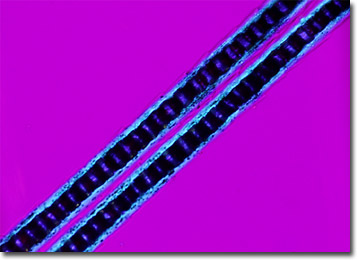Polarized Light Microscopy Digital Image Gallery
Civet Hair
Although sometimes referred to as cats, civets are not felines. They do, however, have catlike bodies and may climb trees, but are members of the family Viverridae, rather than Felidae.

Native to Africa, Asia, and southern parts of Europe, there are about 15 to 20 identified species of civet, although some of these are in danger of extinction. The appearance and behavior of the animals is various, but they are generally nocturnal and have distinctive faces that are similar to that of a weasel. The body length of civets ranges from approximately 16 to 34 inches and their tails may reach lengths as great as 16 inches. In fact, a variety of Asian civet commonly called the binturong is a tree-dweller that can utilize its long, powerful tail to grasp limbs and swing like a monkey. Fur color may be black, gray, brown, reddish, yellowish, and exhibits a wide array of patterns. The pelts of a few civet species are utilized in the fur trade, though they are not in particularly great demand.
The primary use of civets by humans has been in the perfume industry. All civets produce a yellowish, musky substance, which is stored in a pouch under the tail. In nature, the animals use the secretion, also known as civet, as a territorial marker, but it is collected for commercial purposes from those held in captivity. The greasy substance is then utilized as a fixative for perfumes. The civet from which most perfume bases are derived is the Indian civet, which is a ground-dwelling variety found in southern Asia, although other species may also be exploited for such purposes.
